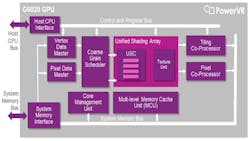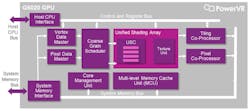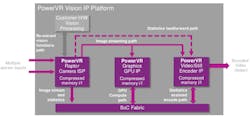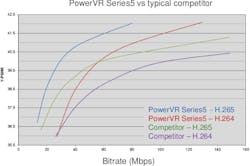Imagination Technologies is known for its 32- and 64-bit MIPS processor, the Ensigma communications processors, and its PowerVR GPUs. The latest offerings in the graphics side include the G6020 GPU (Fig. 1) and the PowerVR Series 5 video encoders. The G6020 is a mid-range solution that is designed to optimize area and efficiency while providing some advanced features like OpenGL ES 3.0 support.
It targets silicon limited SoCs that show up in a range of applications from automotive telematics to entry-level mobile communication devices. The PowerVR GPUs are already found in a range of SoCs such as Ingenic’s JZ4780 found in the Creator CI20 board that includes a dual 32-bit MIPS CPU and a PowerVR SGX 540 GPU (see “What Can You Make with These Development Boards?”).
This GPU is designed for graphics delivery and foregoes the computational OpenCL support of the higher-end Imagination GPUs. The G6020 also lacks high-end GPU features like tessalation that also consume more power. It handles low to mid-range games, but higher-end Imagination GPUs target high-end gaming that requires complex shaders and high-precision math.
What it does deliver is 2D/3D support with smooth animation plus 720p video support. It employs 16-bit floating point support in its energy-efficient ALUs. It works best for gaming applications with a high pixel-to-triangle ratio. It incorporates an ultra-efficient embedded driver and supports standards-based compression.
A complementary piece of IP is the PowerVR Vision platform (Fig. 2) that can handle multiple cameras. An SoC communications fabric allows computational units to share data, minimizing data movement.
The vision platform has a PowerVR GPU at the core. This includes Imagination’s latest GPU. The tight integration of the subsystems lowers latency, even with multiple input cameras and multiple output streams for multiple display applications.
The PowerVR Series 5 video encoders cover a wide range of applications. The PowerVR E5800 targets prosumer applications with 4K60 resolution for UHDTV content. It provides impressive H.264 and H.265 performance with 10-bit 4:2:2 AVC encoding (Fig. 3).
The PowerVR E5505 targets mainstream and premium mobile and tablet devices. These typically need H.265 and H.264 encoding for 4K30 displays. It can also support JPEG and VP8 encoding. The PowerVR E5300 targets wearable and entry-level mobile devices as well as automotive solutions. It can deliver 1080p30 for H.265 and H.264 encoding.
About the Author
William G. Wong
Senior Content Director - Electronic Design and Microwaves & RF
I am Editor of Electronic Design focusing on embedded, software, and systems. As Senior Content Director, I also manage Microwaves & RF and I work with a great team of editors to provide engineers, programmers, developers and technical managers with interesting and useful articles and videos on a regular basis. Check out our free newsletters to see the latest content.
You can send press releases for new products for possible coverage on the website. I am also interested in receiving contributed articles for publishing on our website. Use our template and send to me along with a signed release form.
Check out my blog, AltEmbedded on Electronic Design, as well as his latest articles on this site that are listed below.
You can visit my social media via these links:
- AltEmbedded on Electronic Design
- Bill Wong on Facebook
- @AltEmbedded on Twitter
- Bill Wong on LinkedIn
I earned a Bachelor of Electrical Engineering at the Georgia Institute of Technology and a Masters in Computer Science from Rutgers University. I still do a bit of programming using everything from C and C++ to Rust and Ada/SPARK. I do a bit of PHP programming for Drupal websites. I have posted a few Drupal modules.
I still get a hand on software and electronic hardware. Some of this can be found on our Kit Close-Up video series. You can also see me on many of our TechXchange Talk videos. I am interested in a range of projects from robotics to artificial intelligence.




